Based in Dunnamaggin, Co Kilkenny, the Heffernan family operate a sizeable dairy enterprise milking520spring-calving cows on a grass-based system.
Brothers Mark and Liam farm in partnership alongside their father Billy.
Since Billy starting out dairying in 1983 milking 27 heifers, nothing has stood still.
With cow numbers increasing twentyfold, most aspects of the farm’s infrastructure increased or changed accordingly.
However, one process that went unchanged for the next 37 years was the way in which cubicles were cleaned and bedded.
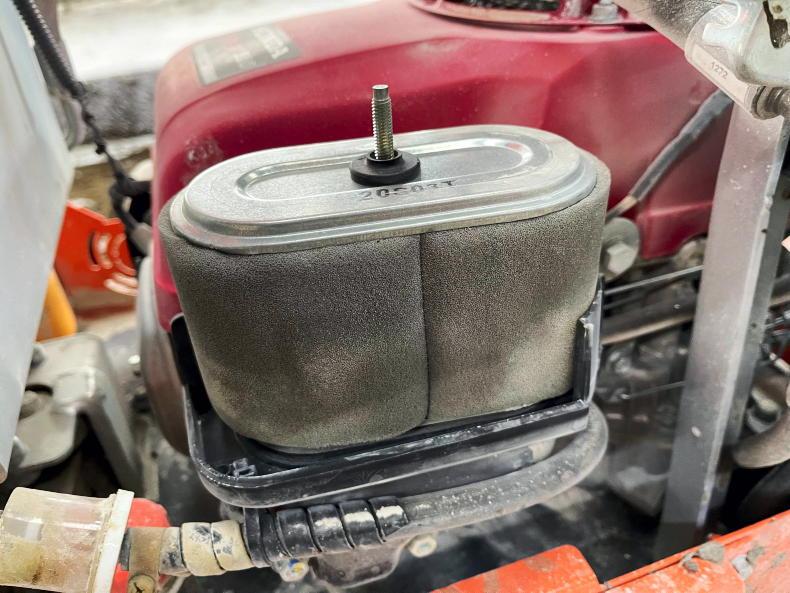
The air filter needs to be blown out once a week.
Manually scraping and bedding cubicles was a time-consuming chore.
Mark said: “From start to finish it was taking one man an hour to an hour and 15 minutes to scrape down and bed 520 cubicles using a squeegee (scraper) and bucket of lime.”
The family found that this was in turn slowing down morning and evening milking times while cows are housed on the shoulders of the year as it was taking a man away from the parlour for too long.
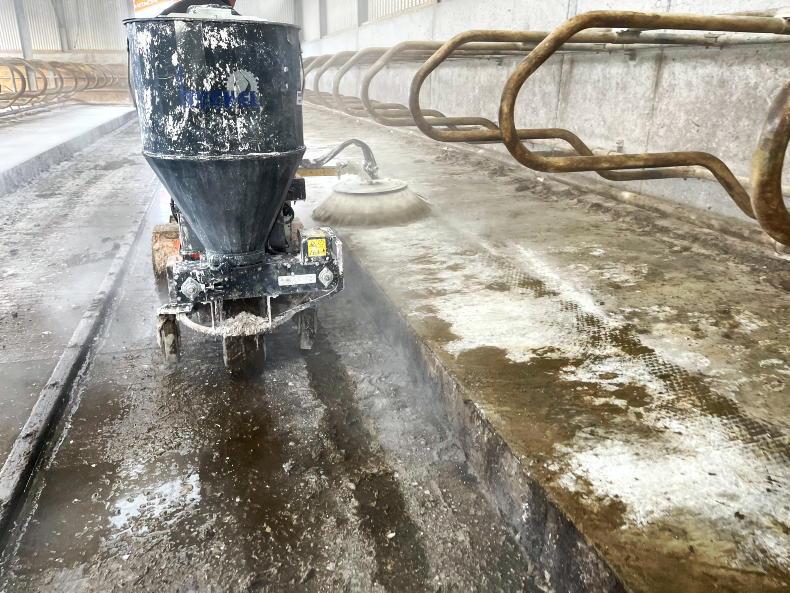
Its compact dimensions leave it easily manoeuvred.
The lads looked into the option of a self-propelled cubicle sweeper/dispenser to save time and labour.
After a successful demonstration last year, they went with the Tuchel-Trac Mini II H based on performance and value for money. Dealer backup from Anner Agri, the Irish importer, also played a key role in their decision.
Brush and dispenser
First up is the 850mm hydraulically powered brush, a major selling point, the Heffernans noted.
The hinged brush arm is swung in and out of working position via one of the two spools and hydraulic cylinder. Brush speed can be adjusted on the move using the flow control valve.
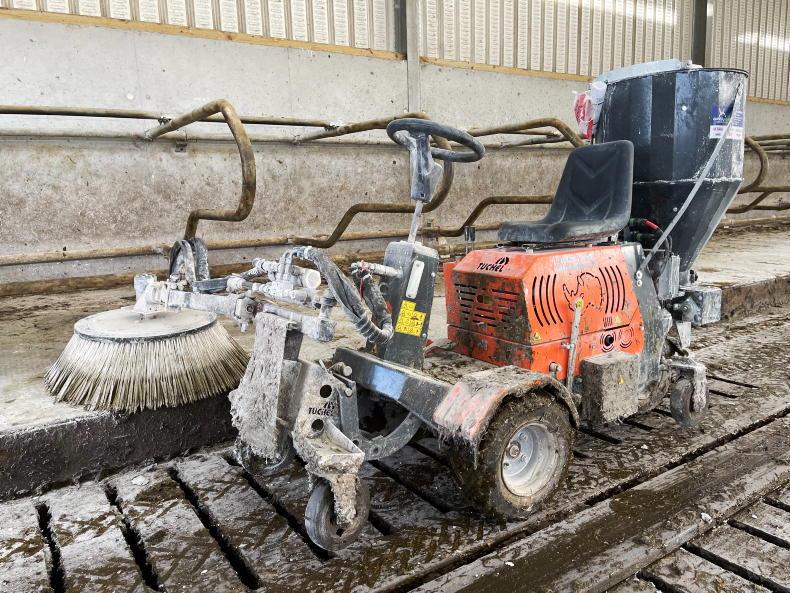
The brush and lime dispenser are Billy and Mark’s standout likes.
Mark said: “It has great power and leaves the cubicles mats cleaner than we could before. It takes the abrasiveness of a brush to clean them whereas the rubber squeegee tended to glide across the dung, especially if it had any time to dry.”
Billy initially expected the brush to wear quite quickly, but is pleasantly surprised with how well it is lasting, still showing little signs of wear.
Mark noted how the brush arm needed to be reinforced but is reassured by the fact Tuchel has since made design changes and offered to modify the machine.
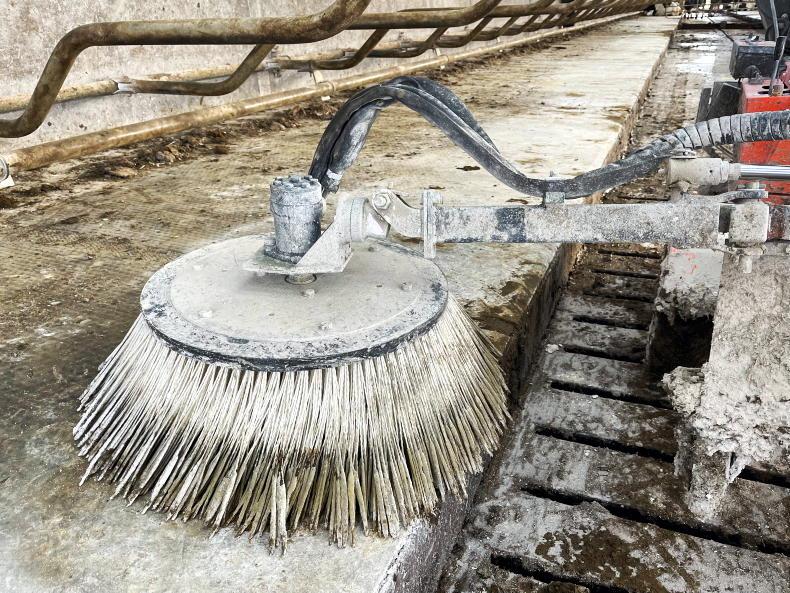
The 600mm brush has great power and leaves a good clean finish.
The rear hopper is mounted over the central rear wheel which steers. Its 150l capacity equates to about three bags (25kg) of lime, Mark said.
There is a manually adjustable shutter to alter material flow onto the conveyor. The lads found setting two (out of 10) to be the sweet spot.
The conveyor motor and hopper agitator motor are powered by the one battery. The power cable is easily disconnected and plugged into the charger.
Similar to the performance of the brush, the spread of the conveyor is a particular standout feature of the Mini II H.
“Some manufacturers use a spinning disc to spread the lime. We found these machines rose more dust.
“Aside from that, the conveyor responds more instantly to speed adjustments. For example, when wanting to throw lime further up on to a particular cubicle.”
The modular design of the machine leaves the hopper and dispenser as an add-on that the lads would have liked to see more integrated and therefore more sturdily mounted.
“Its entire weight is supported from the bottom. Mark commended Anner Agri for arriving out and bracing it on their own accord to prevent any issues down the line.
Drivetrain
Under the driver’s seat is a single-cylinder, Honda air-cooled petrol engine.
Producing a total of 10hp, the engine is similar in size to that found in a small ride on lawnmower. Since the rear dispenser is battery operated, the engine just powers the hydrostatic wheel motors and the brush motor.
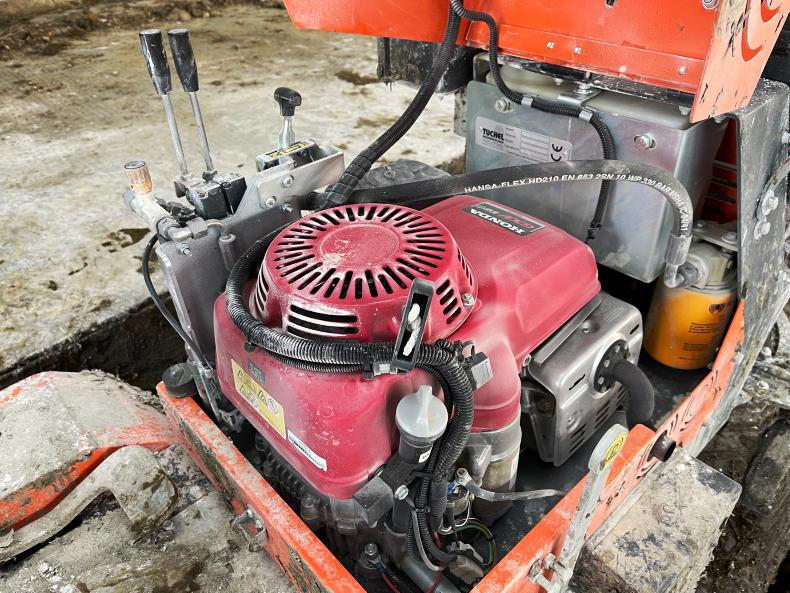
It is fitted with a 10hp single-cylinder Honda petrol engine.
Mark said: “It’s a simple machine to operate and for 10hp it has enough power for its purpose. Forward and reverse is on the one pedal.” Top forward speed is 6.3km/h and 5.5km/h in reverse.
“Controls are simple. The hand throttle has a choke position for startup. Two spool levers control the brush, one to swing it in or out of place and the second to start it spinning.
“The dispenser control box has two switches and a battery charge level indicator. One switch is for on, off and standby, while the other switch adjusts the conveyor speed.”
Since The Tuchel-Trac Mini II H is essentially a tool carrier, the front brush is mounted on a small headstock.
This provides the flexibility of being able to interchange it for some of Tuchel’s other implements such as a yard scraper or silage pusher.
Now just weeks into its second winter, just over 75 hours have been clocked up which is quite a bit for a machine of its kind after one winter.
“It’s a machine that you wouldn’t do without having got used to it; one we should have bought years ago,” Mark said.
“We’re saving in the region of an hour and a half daily during peak. This equates roughly to a day’s work per week when time is needed most on the farm with cows calving and feeding among other jobs to be done.
“Now that there is more control over the amount of lime spread, we saw a 25% saving in the amount of lime used.
“The real beauty is that the job is done in one pass, saving time and strain on the body. We believe if you put a price on time and the lime savings, the machine will not be long paying for itself.
“Two tanks of petrol and two charges of the battery will see a busy week through. Maintenance is only a matter of keeping the air filter blown out and the brush arm greased every now and again
“We were told there is a new 14hp diesel model coming next year which features a self-loading hydraulically driven hopper and a mid-mounted scraper. We’d be keen to demo one of these machines,” Mark said.
Based in Dunnamaggin, Co Kilkenny, the Heffernan family operate a sizeable dairy enterprise milking520spring-calving cows on a grass-based system.
Brothers Mark and Liam farm in partnership alongside their father Billy.
Since Billy starting out dairying in 1983 milking 27 heifers, nothing has stood still.
With cow numbers increasing twentyfold, most aspects of the farm’s infrastructure increased or changed accordingly.
However, one process that went unchanged for the next 37 years was the way in which cubicles were cleaned and bedded.

The air filter needs to be blown out once a week.
Manually scraping and bedding cubicles was a time-consuming chore.
Mark said: “From start to finish it was taking one man an hour to an hour and 15 minutes to scrape down and bed 520 cubicles using a squeegee (scraper) and bucket of lime.”
The family found that this was in turn slowing down morning and evening milking times while cows are housed on the shoulders of the year as it was taking a man away from the parlour for too long.

Its compact dimensions leave it easily manoeuvred.
The lads looked into the option of a self-propelled cubicle sweeper/dispenser to save time and labour.
After a successful demonstration last year, they went with the Tuchel-Trac Mini II H based on performance and value for money. Dealer backup from Anner Agri, the Irish importer, also played a key role in their decision.
Brush and dispenser
First up is the 850mm hydraulically powered brush, a major selling point, the Heffernans noted.
The hinged brush arm is swung in and out of working position via one of the two spools and hydraulic cylinder. Brush speed can be adjusted on the move using the flow control valve.

The brush and lime dispenser are Billy and Mark’s standout likes.
Mark said: “It has great power and leaves the cubicles mats cleaner than we could before. It takes the abrasiveness of a brush to clean them whereas the rubber squeegee tended to glide across the dung, especially if it had any time to dry.”
Billy initially expected the brush to wear quite quickly, but is pleasantly surprised with how well it is lasting, still showing little signs of wear.
Mark noted how the brush arm needed to be reinforced but is reassured by the fact Tuchel has since made design changes and offered to modify the machine.

The 600mm brush has great power and leaves a good clean finish.
The rear hopper is mounted over the central rear wheel which steers. Its 150l capacity equates to about three bags (25kg) of lime, Mark said.
There is a manually adjustable shutter to alter material flow onto the conveyor. The lads found setting two (out of 10) to be the sweet spot.
The conveyor motor and hopper agitator motor are powered by the one battery. The power cable is easily disconnected and plugged into the charger.
Similar to the performance of the brush, the spread of the conveyor is a particular standout feature of the Mini II H.
“Some manufacturers use a spinning disc to spread the lime. We found these machines rose more dust.
“Aside from that, the conveyor responds more instantly to speed adjustments. For example, when wanting to throw lime further up on to a particular cubicle.”
The modular design of the machine leaves the hopper and dispenser as an add-on that the lads would have liked to see more integrated and therefore more sturdily mounted.
“Its entire weight is supported from the bottom. Mark commended Anner Agri for arriving out and bracing it on their own accord to prevent any issues down the line.
Drivetrain
Under the driver’s seat is a single-cylinder, Honda air-cooled petrol engine.
Producing a total of 10hp, the engine is similar in size to that found in a small ride on lawnmower. Since the rear dispenser is battery operated, the engine just powers the hydrostatic wheel motors and the brush motor.

It is fitted with a 10hp single-cylinder Honda petrol engine.
Mark said: “It’s a simple machine to operate and for 10hp it has enough power for its purpose. Forward and reverse is on the one pedal.” Top forward speed is 6.3km/h and 5.5km/h in reverse.
“Controls are simple. The hand throttle has a choke position for startup. Two spool levers control the brush, one to swing it in or out of place and the second to start it spinning.
“The dispenser control box has two switches and a battery charge level indicator. One switch is for on, off and standby, while the other switch adjusts the conveyor speed.”
Since The Tuchel-Trac Mini II H is essentially a tool carrier, the front brush is mounted on a small headstock.
This provides the flexibility of being able to interchange it for some of Tuchel’s other implements such as a yard scraper or silage pusher.
Now just weeks into its second winter, just over 75 hours have been clocked up which is quite a bit for a machine of its kind after one winter.
“It’s a machine that you wouldn’t do without having got used to it; one we should have bought years ago,” Mark said.
“We’re saving in the region of an hour and a half daily during peak. This equates roughly to a day’s work per week when time is needed most on the farm with cows calving and feeding among other jobs to be done.
“Now that there is more control over the amount of lime spread, we saw a 25% saving in the amount of lime used.
“The real beauty is that the job is done in one pass, saving time and strain on the body. We believe if you put a price on time and the lime savings, the machine will not be long paying for itself.
“Two tanks of petrol and two charges of the battery will see a busy week through. Maintenance is only a matter of keeping the air filter blown out and the brush arm greased every now and again
“We were told there is a new 14hp diesel model coming next year which features a self-loading hydraulically driven hopper and a mid-mounted scraper. We’d be keen to demo one of these machines,” Mark said.






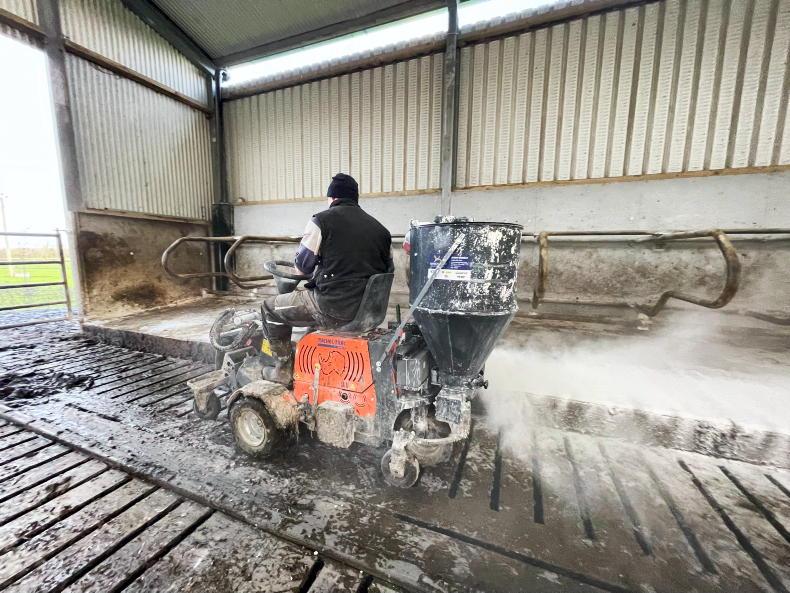




 This is a subscriber-only article
This is a subscriber-only article









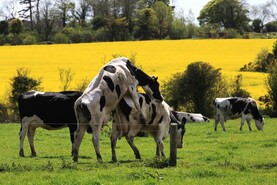
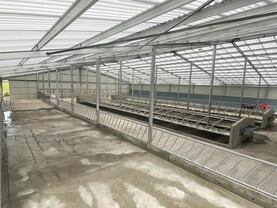
SHARING OPTIONS: